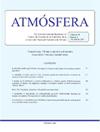利用原位气象观测和gps水汽资料了解热带高海拔地区的对流风暴
IF 1
4区 地球科学
Q4 METEOROLOGY & ATMOSPHERIC SCIENCES
引用次数: 7
摘要
我们调查了哥伦比亚热带安第斯山脉的高海拔和人口稠密地区波哥大萨巴纳上空的对流风暴。使用红外卫星图像和现场降水数据识别对流事件。正如预期的那样,对流在两个雨季的下午早些时候出现了强烈的峰值。先前的研究假设,下午早些时候的西风及其来自温暖的马格达莱纳山谷的湿气平流是强烈风暴的主要解释机制。我们发现,78%的雨季出现午后西风,但只有26%的雨季出现对流事件。因此,尽管西风带由于其产生的辐合作用,似乎对对流是必要的,但它们只是偶尔产生风暴,因此不是一个好的预测因子。此外,再分析数据表明,马格达莱纳山谷的可降水量(PWV)在对流日异常低,这表明湿气在局部聚集,而不是从西部平流。基于地表风速、气温、气压和GPS导出的PWV的组合,我们确定了与深层对流相关的最显著信号:整个上午的风速低于平均水平,接近中午时地表气温高于正常值,随后PWV和风速异常急剧增加。这些特征表明,对流是由西风辐合促进的强日强迫,加上足够的水汽辐合造成的,时间尺度约为3小时。这突出了全球导航卫星系统台站提供的PWV高时间分辨率监测的相关性。本文章由计算机程序翻译,如有差异,请以英文原文为准。
Understanding convective storms in a tropical, high-altitude location with in-situ meteorological observations and GPS-derived water vapor
We investigate convective storms over the Sabana de Bogotá, a high-altitude and densely populated area in the Colombian tropical Andes. Convective events are identified using infrared satellite images and in-situ precipitation data. As expected, convection shows a strong early-afternoon peak during the two rainy seasons. Previous studies hypothesize that early-afternoon westerly winds and their moisture advection from the warmer Magdalena Valley are the main explanatory mechanism for intense storms. We find that early-afternoon westerlies are present in 78% of the rainy season days, but convective events develop in only 26% of the days. Thus, although westerlies seem necessary for convection due to the convergence they generate, they only occasionally generate storms, and are therefore not a good predictor. Furthermore, reanalysis data indicate that precipitable water vapor (PWV) at the Magdalena Valley is anomalously low during convective days, suggesting that moisture converges locally instead of being advected from the west. Based on composites of surface wind speed, air temperature, pressure and GPS-derived PWV, we identify the most prominent signals associated to deep convection: a weaker than average wind speed throughout the morning, higher than normal values of surface air temperature towards noon, followed by an anomalous steep increase of PWV and wind speed. These features indicate that convection results from a strong diurnal forcing facilitated by convergence of westerly winds, combined with sufficient water vapor convergence, with a timescale of about 3 hours. This highlights the relevance of high temporal resolution monitoring of PWV offered by Global Navigational Satellite System stations.
求助全文
通过发布文献求助,成功后即可免费获取论文全文。
去求助
来源期刊

Atmosfera
地学-气象与大气科学
CiteScore
2.20
自引率
0.00%
发文量
46
审稿时长
6 months
期刊介绍:
ATMÓSFERA seeks contributions on theoretical, basic, empirical and applied research in all the areas of atmospheric sciences, with emphasis on meteorology, climatology, aeronomy, physics, chemistry, and aerobiology. Interdisciplinary contributions are also accepted; especially those related with oceanography, hydrology, climate variability and change, ecology, forestry, glaciology, agriculture, environmental pollution, and other topics related to economy and society as they are affected by atmospheric hazards.
 求助内容:
求助内容: 应助结果提醒方式:
应助结果提醒方式:


